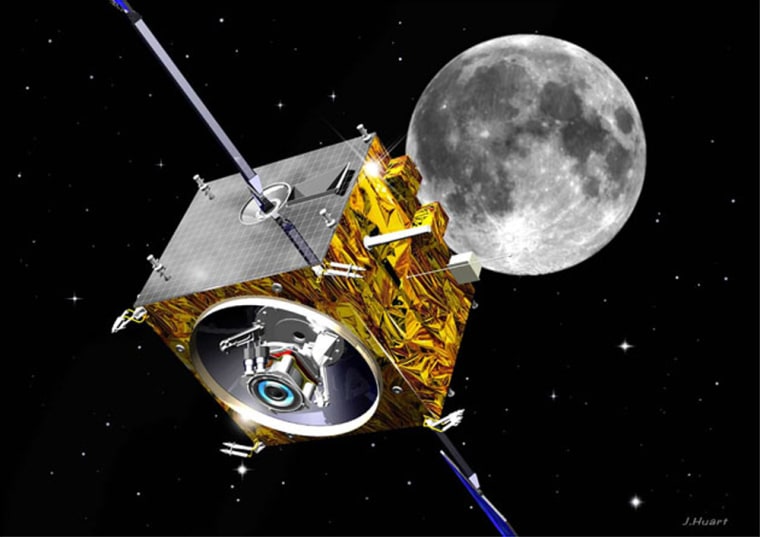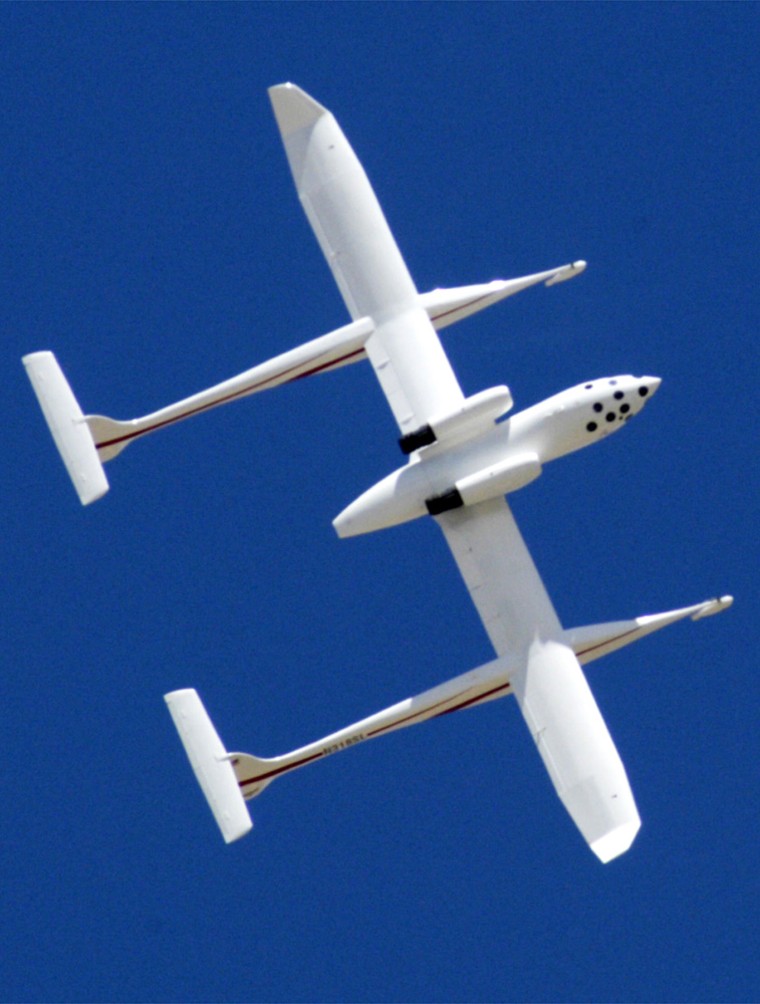On the outer-space front, 2004 has gotten off to a good start with the double interplanetary triumphs of the Stardust comet probe and the Spirit rover on Mars. Now the new Bush space initiative promises to accelerate human exploration beyond Earth orbit, towards the moon, Mars and nearby asteroids.
If these well-earned successes and far-ranging plans set the standards for space activities during the rest of the year, it's going to be very exciting indeed.
Human spaceflight faces a number of challenges, some obvious and some not. The president's announcement in the midst of an election year will contribute to serious soul-searching on national space policy.
Science missions — particularly interplanetary probes — continue to harvest remarkable and exciting discoveries and promise even more, with Mercury, Saturn and lesser objects coming into range again this year. And new players — both China and private companies — are moving into the human spaceflight arena.
Challenges for human spaceflight
NASA's most obvious challenge is to get the space shuttle fleet flying again, following the Columbia catastrophe a year ago. All the steps necessary to prevent a replay of that disaster — when a piece of insulation from the main fuel tank punched a hole in the heat shield on one wing, and blasé NASA officials neglected to check the damage or prepare rescue plans — are now falling into place. However, a repair kit that could fix a similar hole in the wing's leading edge is proving more complicated than hoped.
Also more complicated is the drive to reform NASA's "safety culture," which had grown careless and overconfident. Top officials who were responsible for preventing the shuttle disaster still hold their old jobs, while midlevel officials have been shuffled and new organizations have been chartered. This attempted cultural revolution is "a work in progress," a high NASA official admitted privately to MSNBC.com, and for every sign of progress in some areas there are matching signs of "business as usual" in others.
An even more serious drama, behind the scenes, is whether the international space station, now staffed by a caretaker crew of two men, can hold on until shuttles begin carrying new spare parts and relief supplies late this year. The recent air leak is a portent of things to come, as the station ages and becomes more like Mir (here's hoping it proves as robust as that old Russian station).
Without the shuttle's ability to bring large quantities of big spare parts into space quickly, the possibility grows month by month of a sudden, serious equipment breakdown forcing evacuation of the station. This could then lead to its total loss.
As it is, the multinational partnership behind the project is threatening to buckle under the schedule slips and soaring costs, and with no near-term prospect of increasing the permanent crew size large enough to include representatives of Europe, Japan and Canada. The good news is that Russia continues to profit enough from Western sales of space hardware and services that it can afford to divert some of those funds for continued financing of supply flights (the next on Jan. 29) and station crews (the next in mid-April).
With the end of space shuttle operations now in sight, a replacement spacecraft for humans must be designed and developed quickly. Rational plans for short-term solutions remain elusive, as the expendable spacecraft formerly known as the Orbital Space Plane drifts aimlessly in search of a credible mission and a feasible design. This is the year that NASA must get serious about these options.
Golden age for robotic spaceflight
This year will see the end of the Cassini probe's seven-year voyage out to Saturn, and the beginning of its exploration of that planet, its moons and rings. Arrival is set for July 1. A European-built probe to land on the moon Titan will be deployed from Cassini at the end of the year.
In May, the first probe to Mercury in 30 years will be launched. Messenger will make repeated flybys of Venus and Mercury as it sets up a gentle final approach that will put it into orbit around the target world in 2009.
Promising new and efficient propulsion systems will be flying in 2004.

Europe's ion-drive moon probe, SMART-1, will spend the entire year gradually raising its orbit around Earth, before reaching the moon early in 2005 — the longest, but most fuel-efficient, lunar voyage in history.
Reportedly, Japan plans a Lunar-A orbital mission in the fall that includes dropping a penetrator probe onto the moon's far side, but there's been no official word lately. And the privately funded Trailblazer lunar probe, once expected this year, has also not shown expected progress.
Meanwhile, the nonprofit Planetary Society will be sending a solar sail into low orbit to practice using photon pressure from the sun to push itself high into space. Another innovative space transportation system, funded by Europe and flown by Russia, will further test the use of lightweight, inflatable heat shields for returning from space to Earth.
At the end of the year, NASA's Deep Impact probe will be launched to hit the Comet Tempel 1 in mid-2005 and analyze samples (registration to get your name on a CD to be carried to the comet lasts until the end of this month).
Last year's scheduled launch of Europe's sophisticated Rosetta comet lander was canceled out of concerns about booster reliability. It is now due for launch on Feb. 26 for a 10-year voyage past at least one asteroid, ending up on the surface of Comet 67P Cheryumov-Gerasimenko.
While the Stardust probe is on its two-year return voyage to Earth with particles from the comet it encountered earlier this month, the first samples collected from beyond the moon will land this September aboard the Genesis capsule, which collected solar wind particles from a point a million miles sunward of Earth. And Japan's ambitious Muses-C asteroid sample return mission, launched last year, will fly past Earth once this year to boost its orbit for a landing on Asteroid 1998 SF36 in mid-2005 and a return to Earth two years later.
New members of the space club
China broke into the exclusive U.S.-Russian "space club" of human orbital flight with its launch of the Shenzhou 5 vehicle with astronaut Yang Liwei. The next mission, Shenzhou 6, is now expected to be a two-man weeklong flight, perhaps as early as this fall. It will lead to a small Chinese space station all their own, and their role in the international space station remains to be defined. Meanwhile, Russia will be resuming space tourism missions by commercial customers, as early as this October.

The other eagerly anticipated "space tourism" angle deals with short up-down rocket hops to the edge of space, perhaps 60 to 100 miles high. This is the year, experts expect, that the first fully private spaceflights will be accomplished by at least one commercial group. Success will open the way for a significant tourism industry, as well as encourage development of even more powerful private rockets that may be capable of orbital flight within five years.
Deliberately below the radar screen of public attention, massive expenditures for Pentagon spy satellites are being reassessed based on hardware problems and on the stark change in the nature of international adversaries. The less attention such hardware gets, the more the Department of Defense likes it. Occasional reports of scandalous cost overruns and space breakdowns often distract attention from the very successful — and very secret — programs.
Commercial spending on space activities continues to increase, mainly in communications and navigation technology, but also in Earth surface imaging.
Worldwide, private companies are spending more money on space-related activities than governments are. Many of these services have become so fully integrated into modern life that their space connection is unrecognized. They only attract attention when they fail to provide expected services.
Lastly, space by its very nature is an arena of surprises. Discoveries can be exciting, and disasters can be dismaying. But 2004 promises, above all, to be anything but boring.